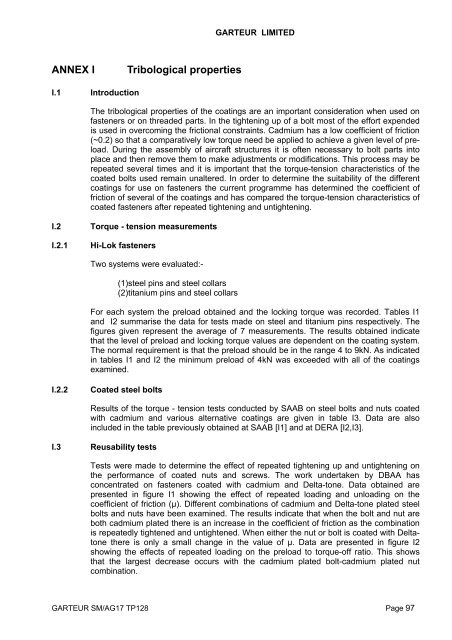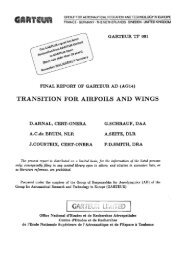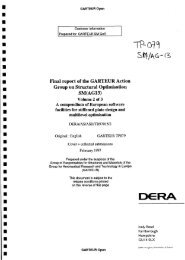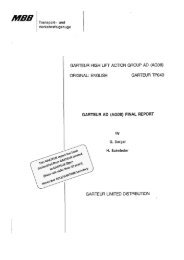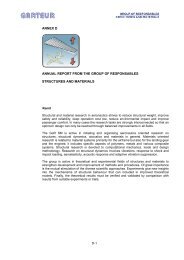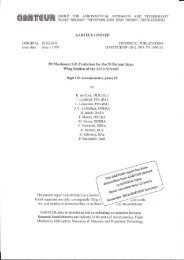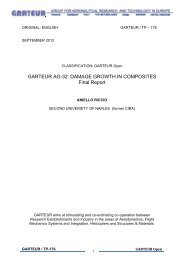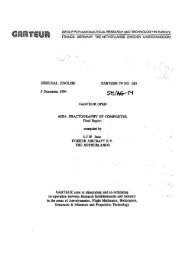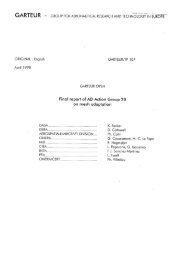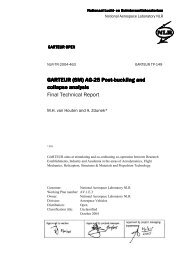Cadmium Substitution - garteur
Cadmium Substitution - garteur
Cadmium Substitution - garteur
You also want an ePaper? Increase the reach of your titles
YUMPU automatically turns print PDFs into web optimized ePapers that Google loves.
GARTEUR LIMITED<br />
ANNEX I<br />
Tribological properties<br />
I.1 Introduction<br />
The tribological properties of the coatings are an important consideration when used on<br />
fasteners or on threaded parts. In the tightening up of a bolt most of the effort expended<br />
is used in overcoming the frictional constraints. <strong>Cadmium</strong> has a low coefficient of friction<br />
(~0.2) so that a comparatively low torque need be applied to achieve a given level of preload.<br />
During the assembly of aircraft structures it is often necessary to bolt parts into<br />
place and then remove them to make adjustments or modifications. This process may be<br />
repeated several times and it is important that the torque-tension characteristics of the<br />
coated bolts used remain unaltered. In order to determine the suitability of the different<br />
coatings for use on fasteners the current programme has determined the coefficient of<br />
friction of several of the coatings and has compared the torque-tension characteristics of<br />
coated fasteners after repeated tightening and untightening.<br />
I.2 Torque - tension measurements<br />
I.2.1<br />
Hi-Lok fasteners<br />
Two systems were evaluated:-<br />
(1) steel pins and steel collars<br />
(2) titanium pins and steel collars<br />
For each system the preload obtained and the locking torque was recorded. Tables I1<br />
and I2 summarise the data for tests made on steel and titanium pins respectively. The<br />
figures given represent the average of 7 measurements. The results obtained indicate<br />
that the level of preload and locking torque values are dependent on the coating system.<br />
The normal requirement is that the preload should be in the range 4 to 9kN. As indicated<br />
in tables I1 and I2 the minimum preload of 4kN was exceeded with all of the coatings<br />
examined.<br />
I.2.2<br />
Coated steel bolts<br />
Results of the torque - tension tests conducted by SAAB on steel bolts and nuts coated<br />
with cadmium and various alternative coatings are given in table I3. Data are also<br />
included in the table previously obtained at SAAB [I1] and at DERA [I2,I3].<br />
I.3 Reusability tests<br />
Tests were made to determine the effect of repeated tightening up and untightening on<br />
the performance of coated nuts and screws. The work undertaken by DBAA has<br />
concentrated on fasteners coated with cadmium and Delta-tone. Data obtained are<br />
presented in figure I1 showing the effect of repeated loading and unloading on the<br />
coefficient of friction (μ). Different combinations of cadmium and Delta-tone plated steel<br />
bolts and nuts have been examined. The results indicate that when the bolt and nut are<br />
both cadmium plated there is an increase in the coefficient of friction as the combination<br />
is repeatedly tightened and untightened. When either the nut or bolt is coated with Deltatone<br />
there is only a small change in the value of μ. Data are presented in figure I2<br />
showing the effects of repeated loading on the preload to torque-off ratio. This shows<br />
that the largest decrease occurs with the cadmium plated bolt-cadmium plated nut<br />
combination.<br />
GARTEUR SM/AG17 TP128 Page 97


